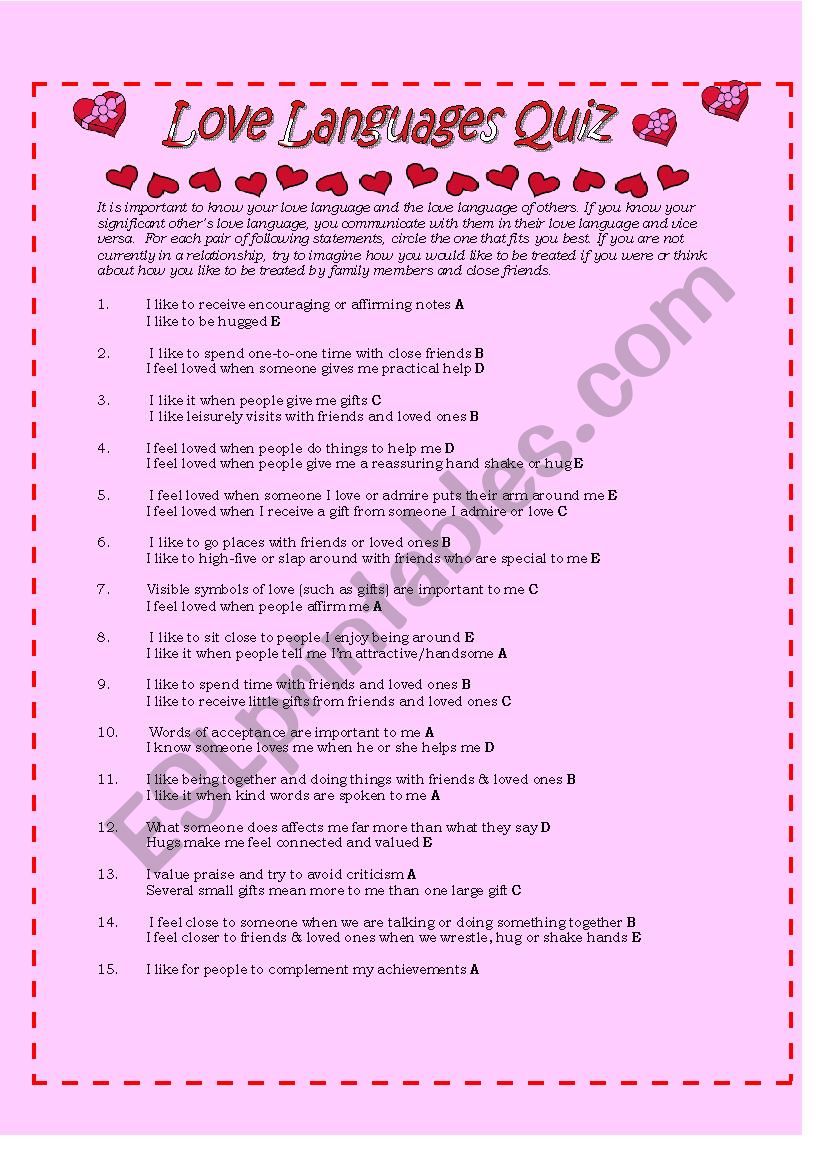The 5 Love Languages: Understanding Love in Asian Cultures
 In different cultures around the world, the way we express and perceive love can vary greatly. Love is a universal language, but the dialects and nuances differ from one community to another. Asian cultures, in particular, have their own unique perspectives and practices when it comes to expressing affection and love. This article explores how the concept of love is understood in Asian communities through the lens of the 5 Love Languages.
In different cultures around the world, the way we express and perceive love can vary greatly. Love is a universal language, but the dialects and nuances differ from one community to another. Asian cultures, in particular, have their own unique perspectives and practices when it comes to expressing affection and love. This article explores how the concept of love is understood in Asian communities through the lens of the 5 Love Languages.
Image: 50 5 Love Languages Worksheet
 The 5 Love Languages, a concept popularized by Dr. Gary Chapman, proposes that people express and receive love in five primary ways: Words of Affirmation, Acts of Service, Receiving Gifts, Quality Time, and Physical Touch. While these love languages hold true across cultures, the specific manifestations and significance of each language can differ based on cultural context.
The 5 Love Languages, a concept popularized by Dr. Gary Chapman, proposes that people express and receive love in five primary ways: Words of Affirmation, Acts of Service, Receiving Gifts, Quality Time, and Physical Touch. While these love languages hold true across cultures, the specific manifestations and significance of each language can differ based on cultural context.
Image: 7 Love Language Quiz Ideas
 In Asian cultures, where collectivism and interdependence are highly valued, Words of Affirmation often play a crucial role in expressing love. Telling someone you love them or expressing appreciation for their qualities and actions is deeply meaningful. Compliments and words that uplift and encourage your loved ones are seen as a form of emotional support and validation.
In Asian cultures, where collectivism and interdependence are highly valued, Words of Affirmation often play a crucial role in expressing love. Telling someone you love them or expressing appreciation for their qualities and actions is deeply meaningful. Compliments and words that uplift and encourage your loved ones are seen as a form of emotional support and validation.
Image: Love Language Quiz for Kids worksheet in 2021
 Acts of Service are also highly regarded in many Asian cultures. The idea of showing love through actions and tangible help is deeply ingrained. Taking care of practical matters, assisting with chores or daily responsibilities, and going out of your way to support someone are all seen as gestures of love and care.
Acts of Service are also highly regarded in many Asian cultures. The idea of showing love through actions and tangible help is deeply ingrained. Taking care of practical matters, assisting with chores or daily responsibilities, and going out of your way to support someone are all seen as gestures of love and care.
Image: Free Printable Love Language Quiz
 Giving and receiving gifts also hold a special place in Asian cultures, representing thoughtfulness and consideration. The act of selecting a meaningful gift or token of appreciation is seen as an expression of love and understanding. In many Asian countries, gift-giving is associated with important occasions such as birthdays, weddings, and festivals.
Giving and receiving gifts also hold a special place in Asian cultures, representing thoughtfulness and consideration. The act of selecting a meaningful gift or token of appreciation is seen as an expression of love and understanding. In many Asian countries, gift-giving is associated with important occasions such as birthdays, weddings, and festivals.
Image: 5 Love Languages Quiz
 Quality Time, spending uninterrupted and focused moments together, is an essential love language in Asian cultures. Being fully present and engaged in conversations, shared activities, and meals is highly valued. In many Asian households, meal times serve as an opportunity for the family to bond, communicate, and show love through the act of sharing a meal.
Quality Time, spending uninterrupted and focused moments together, is an essential love language in Asian cultures. Being fully present and engaged in conversations, shared activities, and meals is highly valued. In many Asian households, meal times serve as an opportunity for the family to bond, communicate, and show love through the act of sharing a meal.
Image: 5 Love Languages Quiz PDF for Couples

Image: Redefining Our Love Languages
 Understanding the different love languages and their cultural context is crucial in building stronger relationships, not just in Asian cultures but across the globe. It allows us to appreciate and respect the diverse ways in which love is expressed and received. By learning to speak each other’s love languages, we can foster deeper connections and create more harmonious bonds, regardless of cultural backgrounds.
Understanding the different love languages and their cultural context is crucial in building stronger relationships, not just in Asian cultures but across the globe. It allows us to appreciate and respect the diverse ways in which love is expressed and received. By learning to speak each other’s love languages, we can foster deeper connections and create more harmonious bonds, regardless of cultural backgrounds.
Image: Love Languages Quiz
 As society becomes more interconnected, it is important to celebrate and learn from the cultural differences in expressing love. The 5 Love Languages provide a framework for understanding the various ways in which individuals communicate love and affection. By embracing these differences, we can bridge the gaps and cultivate a more inclusive and understanding world.
As society becomes more interconnected, it is important to celebrate and learn from the cultural differences in expressing love. The 5 Love Languages provide a framework for understanding the various ways in which individuals communicate love and affection. By embracing these differences, we can bridge the gaps and cultivate a more inclusive and understanding world.
Image: The 5 Love Languages: What is your Love Language? and How to Speak Your
 Love, at its core, is a beautiful bond that transcends borders and cultures. Asian cultures have rich traditions and practices that beautifully express love and affection. By embracing and understanding these unique perspectives on love, we can expand our own capacity for love and foster deeper connections with the Asian communities around us.
Love, at its core, is a beautiful bond that transcends borders and cultures. Asian cultures have rich traditions and practices that beautifully express love and affection. By embracing and understanding these unique perspectives on love, we can expand our own capacity for love and foster deeper connections with the Asian communities around us.
These images and quotes remind us that love is a universal language that is expressed in diverse and beautiful ways. Regardless of our cultural backgrounds, we must strive to respect and appreciate these differences and seek to learn from one another.
Love is at the heart of our human experience, and through understanding and embracing the 5 Love Languages, we can build stronger and more meaningful relationships with everyone around us.